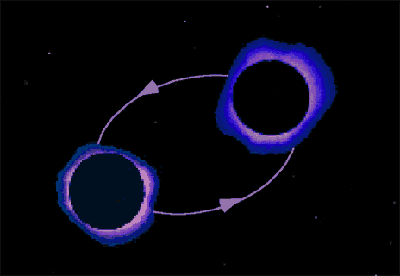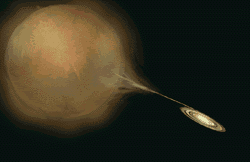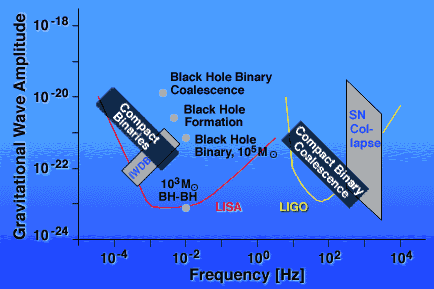|
An artist's impression of a binary black
hole system. The false purple colouring shows the position of the holes' event horizons. |
 |
Coalescing black
holes or neutron stars are the most promising sources for future detection.
When these compact objects exist in binaries, the orbital motion produces gravitational
waves which carry away energy, causing the objects to inspiral. An artist's
impression of a black hole binary is shown below. As the two objects inspiral
closer the power emitted in gravitational waves increases until merger, producing
a characteristic waveform called a chirp signal. Predictions of this characteristic
signal would enable the use of pattern matching techniques which greatly increase
the probability of detection. Accurate predictions depend on modelling the sources
using computer simulations.
|
An artist's impression of a binary black
hole system. The false purple colouring shows the position of the holes' event horizons. |
 |
Individual neutron stars could
also be a promising source. If a neutron star is spinning and if it is not perfectly
symmetric about its rotation axis then it will emit gravitational waves. There
are a number of ways in which such asymmetries might be produced. For instance,
there might exist a small `mountain' in its crust, the pulsation modes of its
fluid core might be excited, or it may be undergoing a wobbling motion known
as free precession. Some neutron stars are continuously fed gas from
a nearby non-compact star, a process known as accretion. Such an
accreting binary system could be a good source of gravitational radiation, as
the energy of the accreting gas might be continuously converted into gravitational
wave energy.
|
An artist's impression of accretion onto a neutron
star in a binary system.
The small disk on the right is known as the accretion disk. A neutron stars or black hole may reside at its centre. |
 |
It is also predicted that there should be a background of gravitational waves left over from the big bang. Detection of these waves could reveal what the universe was like when it was only a fraction of a second old, allowing us to test cosmology theory.
Detection of gravitational waves from sources such as these would not only serve as confirmation of Einstein's theory of general relativity, it could also provide a whole new window to the universe. As well as finding out new information about known astrophysical objects, gravitational wave astronomy could lead to discoveries of previously unknown objects far beyond our imagination.
 |
The gravitational-wave sky: The sources that might be detected by the
space-based LISA mission, and a ground-based detector (LIGO). Wave
frequency is plotted on the horizontal axis, and wave strength on the vertical.
Sources that lie above the red curve could be detected by LISA, and sources
above the yellow could be detected by LIGO. Because of its larger
size, LISA is sensitive to much lower frequencies than the ground-based
detectors. |